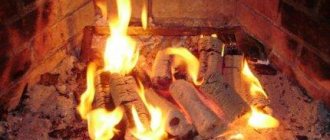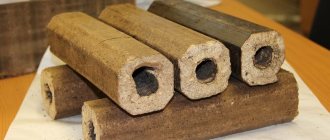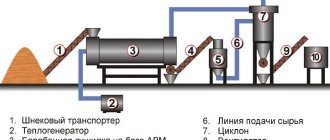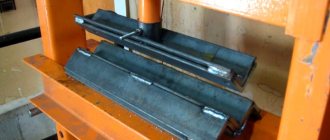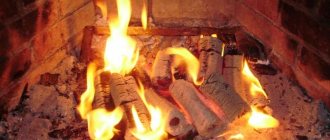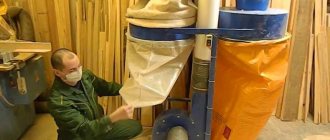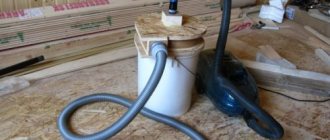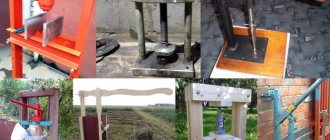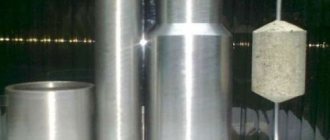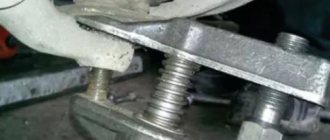Just recently, a new solid fuel for stoves and boilers appeared on the domestic construction market, the manufacturers of which position it as a cost-effective alternative to conventional firewood. The fuel is called Eurowood or fuel briquettes, and it is made from the remains of natural materials, for example, wood, paper, straw, seed husks, nut shells.
The process of producing fuel briquettes is simple, it is necessary to prepare the raw materials and compress them under high pressure, or heat treatment can also be carried out. The resulting product will be dense, dry, and ready for use in the oven. In this article we will talk about what equipment is needed for the production of fuel briquettes, consider the composition of an industrial production line and alternative equipment options for home production of such products.
Production line for creating RUF fuel briquettes
Features of the production of fuel briquettes
Fuel is made from the following types of raw materials:
- sawdust, wood chips, shavings, bark;
- cake, sunflower husks, husks of other seeds, incl. croup;
- peat;
- coal dust.
Briquettes made from wood waste are the most common.
Physics of the process
A portion of crushed raw materials is loaded into a mold and compressed with a press with a force of up to 3000 kg/sq.cm.
The output is a block with a higher density than wood: 1.08–1.40 g/cc versus 0.75–0.85. This fuel burns longer and does not produce sparks.
Application of adhesive
A binder is required to adhere fine particles to each other. Industrial production uses lignin contained in the raw materials themselves. It is a complex biopolymer synthesized by plants. Under the influence of high pressure and the resulting heating, the binder comes out of the cells and impregnates the briquette.
An adhesive is required to hold the particles together.
Thus, factory-made fuel does not contain chemical additives and is therefore environmentally friendly.
Most homemade presses are not capable of developing pressure sufficient to destroy plant cells and squeeze out lignin. Therefore, in home production, third-party binders are used:
- Clay solution. Add in an amount of 5–10% of the total weight of the mixture.
- Corrugated cardboard and other paper (contains lignin). The material is pre-soaked.
- Wallpaper glue. The cheapest one will do.
The proportion of glue and paper is selected experimentally - it depends on the humidity of the raw material and the pressure developed by the press.
The higher the lignin concentration in the wood, the lower the force required to squeeze it out. Data on the most common breeds are given in the table:
| Tree name | Mass fraction of lignin, % |
| Birch | 19 |
| Aspen | 22 |
| Spruce | 27 |
| Pine | 27 |
| Fir | 30 |
If a homemade press develops a lot of pressure, you should first try to make briquettes from softwood sawdust. It is possible that a third-party binder will not be needed.
Requirements for raw materials used
A properly prepared starting mass has the following parameters:
- Humidity – 4–10%. Excessive amounts of water impair combustion.
- Fraction or chip thickness – 2 mm. Large chips are pre-crushed in crushers.
- Lack of grass, sand, leaves, soil; bark content – no more than 5% by weight of the mixture. Such components disrupt the monolithic structure of the bar and make it crumbly.
At enterprises, the moisture content of raw materials is adjusted to the required value in heated dryers. In home production, it is kept in the sun and draft.
When using a third-party binder, sawdust is soaked in it, and the finished product is dried.
Business relevance
It’s sad, but as much as 35 percent of trees cut down in our country goes to waste.
This is a well-known figure and it is huge, considering the volume of timber harvested in Russia. Meanwhile, a question arises for ordinary entrepreneurs. How can you use all these workings that no one needs and start making money selling compressed firewood? Sawdust by itself is not the most cost-effective way to start a fire. They burn well, the combustion area is large, but the percentage of heat released is completely inappropriate. Therefore, this method of using waste wood has not proven itself. In addition, there is a share of release of substances that negatively affect human health after the sawdust burns out.
However, there is a way to use them more intelligently. This is how special wood pellets , called pellets or fuel briquettes, . They are also used for fuel boilers. Such processed wood residues are called Eurowood.
This is a special type of biofuel , which is obtained as a result of the procedure of pressing industrial waste such as sawdust, wood shavings, as well as agricultural waste - straw, crop stems and other material. Molding of Euro firewood comes in various shapes - cylindrical, polygonal, etc.
General information about briquetting press
The equipment is produced in a variety of designs. The developed force varies from 500 to 3000 kgf/sq.cm.
Approximate cost in rubles:
- mini presses – 70,000–100,000;
- budget class models – 200,000;
- multifunctional machines with a long service life - from 300,000 to 1,000,000.
A homemade unit can be made at home from scrap materials.
Purpose
The press compresses fine-grained raw materials until they turn into a dense briquette. Expensive models simultaneously heat the source material to a temperature of +150...300°C, which promotes the release of lignin from plant cells.
The press compresses the raw materials into a dense briquette.
Machines designed for the continuous production of Euro firewood cut them into individual bars.
Design features: main elements
The main components of the press:
- Mixer. Mixes several types of raw materials until a homogeneous mixture is achieved.
- Matrix. Gives raw materials the desired shape.
- Punch. Applies pressure on the original mass.
- Operating mechanism with drive. Converts electrical energy into compression force.
- Bed. The base to which all components are attached.
Some models are additionally equipped with a heater and a knife.
Principle of operation
The mixture enters the matrix, where it is subjected to pressure from the punch. The raw material is compacted with simultaneous molding.
Operating principle of a briquette press.
According to the principle of operation, machines are divided into 2 types:
- Intermittent. During production, the cycle is repeated many times: loading of raw materials – compression – removal of the finished product from the mold.
- Continuous (extruders). Adding raw materials and squeezing out the product occurs constantly, while at the same time the latter is cut into bars.
Eurowood as an alternative to non-renewable energy sources
For the last 150 years, humanity has been intensively developing and burning coal and oil to obtain electrical and thermal energy, as a result of which experts have thought that at some point the deposits of these natural resources will simply dry up.
For this reason, it became necessary to find an alternative replacement for these sources. This problem was partially, but quite successfully solved by the invention of Euro-firewood, which replaced coal. To produce fuel briquettes, you need to purchase a special production line.
Species diversity
There are several types of presses:
- hydraulic;
- screw;
- shock-mechanical;
- granulators.
The differences lie in the method of creating pressure and the characteristics of the briquettes.
Hydraulic
Machines of this type have the following characteristics:
- The production method is intermittent.
- The working mechanism is hydraulic: force is created by pumping oil into the cavity of the hydraulic cylinder.
- Specific pressure – 500–1500 kg/sq.cm.
The hydraulic machine has an intermittent production method.
Raw materials are loaded in portions into a mold (glass). After compression, the finished briquette is removed.
Hydraulic presses have 2 advantages:
- low cost;
- briquettes are shaped like bricks (RUF), which makes transportation and storage easier.
Flaws:
- low productivity;
- relatively low pressure - the density of the bars does not exceed 0.75–0.8 kg/cc.
Screw
Press characteristics:
- The manufacturing method is continuous.
- The working body is a rotating auger (like in a kitchen meat grinder).
- Specific pressure – up to 3000 kg/sq.cm.
The press operates on the principle of extrusion: a screw forces the mixture through a gradually narrowing hole - a die. Due to the conical shape of the channel, the compression force from its walls is several times higher than the pressure developed by the screw. A similar effect is observed when driving a wedge into a crack, which leads to the splitting of a tree trunk.
A screw press forces the mixture through a tapering hole.
Installation benefits:
- High density of briquettes – 1.08–1.40 kg/cc. This fuel burns for a long time and produces a lot of heat.
- High performance. Thanks to the continuous operation of the extruder, it is possible to produce more briquettes per unit of time than with a hydraulic installation.
- The log has a Pini&Kay format - with a hexagonal cross-section and a through hole in the middle. The channel ensures the flow of air to the internal layers and, as a result, the most complete combustion and minimum ash content.
The disadvantage of a screw press is its high cost.
Impact-mechanical
Equipment characteristics:
- The production method is continuous.
- The working body is a rotating crankshaft with a connecting rod attached to it (crank mechanism).
- Specific pressure – up to 2500 kg/sq.cm.
There is another type of extruder, when the raw material is forced through a die by a piston moving back and forth.
In terms of cost and productivity, mechanical impact presses occupy a middle position between hydraulic and screw models. The same can be said about the density of the bar: it is 1–1.15 kg/cc. It has a round cross-section (Nestro type) with a through hole.
The mechanical impact press operates continuously.
The disadvantage of the equipment is accelerated wear of the bearing due to impact.
Despite this, such presses have become widespread due to the optimal combination of installation price and product quality.
Press granulator
This is a universal extruder for the production of fine-grained pressed products. If the raw material is crushed grain, the output is compound feed; if sawdust, peat, seed husks, etc. - fuel granules (pellets). The advantage of small-caliber briquettes is the possibility of automatically feeding them into the combustion chamber of the boiler using a screw or piston feeder. The heat generator must be equipped with a special pellet burner.
Business plan points
In order for everything described above to work and really make a profit, you need to competently draw up a business plan , reflecting all the necessary stages. Among them:
- Search for investment capital. Where will you get the money from, what percentage of it will go to lending.
- Raw materials. Places of supply, prices, costs. Where will the main material come from?
- Purchase of equipment. Supplier, prices, what is included in the payment, what additional costs certain equipment will incur and at what stages.
- Installation. Is it included in the purchased production line? If not, what funds will be spent and how long will it take.
- Registration of individual entrepreneurs. From the size of government duties to hiring an accounting company.
- Tax system. What monthly expenses will be included in the taxes and fees column.
- Staff. Quantity, work schedule, wages, means of hiring, required indicators and skills.
- Launch of the production line. Deadlines, necessary funds.
- Sales of products. Sales lines, export, logistics, main customers, prices, quantity of goods sold over a period of time.
In addition to the above points, you need to reflect the costs of a marketing campaign, analysis of market prospects, other expenses, time and stages of developing a commercial proposal and its effectiveness, and rental of premises. As well as the possible expansion of the enterprise and the timing of achieving net profit.
You can find another 1000 best business models in the sections: Business ideas or Franchise
Press selection criteria: what to look for
When choosing a machine, consider the following:
- Electric motor power. It is limited by the capacity of the circuit breaker at the entrance to the house and the cross-section of the cables. The most energy-intensive are screw units.
- Distance to the supplier's service department. The closer it is located, the faster the repairs will be completed and the less losses there will be from equipment downtime.
- Telephone consultation. A useful service from a supplier or dealer can help you avoid mistakes and save money.
- Volume of available raw materials and market capacity. The costs of purchasing a machine with excessive productivity will be unreasonably high, and along with them the cost of repairs. These factors will increase the payback period of the equipment and lead to a decrease in production profits.
When choosing a machine, consider the power of the electric motor.
Room equipment
The production premises are subject to certain requirements from sanitary services and fire inspectors. The required voltage in the electrical network is 380 V.
Be sure to have sewerage and running water. Also, you should take care of the ventilation of the room.
The area of the production facility depends on the capacity and set of equipment . There are strict safety standards that allow you to calculate the required area.
How to organize the production of double-glazed windows? What equipment is needed for this business? In the material, watch a video about the production of double-glazed windows and learn the important points of this business.
What is the secret of the population's demand for dumplings? Tasty and healthy food will always be fashionable. On this page you will learn how a machine for producing dumplings works.
A confectionery business has every chance of success if all technological requirements are met. From the material you can learn how the production of mini bakeries for confectionery shops is organized.
Methods for creating a device
It is impossible to make an extruder at home. All homemade machines press briquettes into a mold (glass) in an intermittent manner.
The main task of the designer is to ensure a specific pressure of at least 150 kg/sq.cm. This value is determined by 2 factors:
- force generated by the press (direct relationship);
- cross-sectional area of the mold (reverse).
By selecting the ratio of these parameters, the desired characteristics are achieved.
For example, a machine presses on a portion of raw materials with a force of 1350 kgf. If the block has a cross-section of 5x5 cm, the specific pressure will be:
P = 1350 / (5 x 5) = 54 kgf/sq.cm
At such low rates, the briquette will crumble. By reducing the dimensions of its cross-section to 3x3 cm, the designer will increase the specific pressure to:
P1 = 1350 / (3 x 3) = 150 kgf/sq.cm
There are several ways to achieve high force.
The designer's task is to ensure the specific pressure of the press.
Use of muscular strength and leverage
This is the simplest version of the press; all its elements can be made at home.
A strong pipe is used as a lever, for example a reinforced water pipe with a diameter of 40–50 mm and a wall thickness of 4–4.5 (mm). One end of it is equipped with an axis and fixed in a bracket so that the other side can be raised and lowered.
A rod with a punch is attached at a short distance from the point of rotation.
The compression force will be equal to Q = P * (L / L1), where:
- P – operator’s weight acting on the free end of the lever;
- L – pipe length;
- L1 – distance from the point of rotation to the junction of the rod and the punch.
Example:
- operator weighs 90 kg;
- lever length – 3 m;
- the distance from the pipe rotation point to the punch is 0.3 m.
Under these conditions, the compression force will be:
Q = 90 * (3 / 0.3) = 900 kgf
It must be taken into account that the same force acts on the bracket at the point of rotation of the lever, so it must be strong.
To achieve a pressure of 150 kgf/sq.cm, the cross-sectional area of the bar must be equal to:
S = 900 / 150 = 6 sq.cm
The lever installation is designed so that briquetting is carried out in one step. Otherwise, you will have to waste time adding raw materials, which will lead to a decrease in productivity.
The immersion depth of the punch depends on the volume of the portion. It is calculated using the formula A = H * (1 – (p1 / p2)), where:
- H – height of the glass;
- p1 and p2 are the density of raw materials and briquettes, respectively.
The larger A, the further the rod needs to be moved from the point of rotation. But this leads to a decrease in compression force.
The parameters are selected as follows:
- Calculate the cross-sectional area of the pipe from which the glass will be made.
- The required force is calculated and based on this the distance of the rod to the point of rotation is determined.
- A test briquette is made.
- If in 1 approach it was not possible to achieve the required degree of compression, cut off part of the glass to reduce its length.
Formula for calculating the piston pressure force (m) depending on the force applied by a person (M), the distance from the piston to the lever attachment point (l) and its total length (L)
If high productivity is not needed, the briquette is made in several stages, adding more raw materials.
To increase the pressure on the lever, you can attract an assistant.
Application of hydraulic jack
A household hydraulic jack develops a force of 30–40 tf. If you equip a press with it, the available mold area will be:
S = 30000 / 150 = 200 sq.cm
The hydraulic jack develops a lot of force.
This machine can be equipped with several forms. Then the frame for the punches is made of durable rolled products, for example an I-beam or a thick-walled profiled pipe.
The disadvantage of a press based on a hydraulic jack is the long cycle time. But it has higher productivity, and the briquettes are more similar to those made industrially.
The design of a typical hydraulic press consists of a frame and a movable beam on which a jack is placed. The system returns to its original position due to the action of springs
Screw pressing mechanism
Another device for enhancing muscle strength is a screw. The amount of pressure it creates is calculated based on the “golden rule of mechanics”.
L1 / L2 = Q2 / Q1, where:
- L1 – path traveled by the point of application of muscular force;
- L2 – movement of the punch mounted on a screw or lever;
- Q1 – muscular strength;
- Q2 – pressure developed by the press.
Example:
- the length of the handle in the screw shank is 80 cm (2 arms of 40 cm each);
- force applied by the operator – Q1=40 kgf;
- screw thread pitch – 3 mm.
The screw pressing mechanism enhances muscle strength.
For 1 revolution, the point of application of muscular force, i.e. the end of the handle will go the following way:
L1 = 2 * P * 40 = 2 * 3.14 * 40 = 251.2 cm
The punch will drop to L2 = 3 mm = 0.3 cm. The force of its influence on the raw material is equal to:
P2 = (L1 * P1) / L2 = (251.2 * 40) / 0.3 = 33493 kgf
The actual force will be less because The operator will spend part of the energy to overcome friction in the screw-nut pair. The average efficiency of such devices is 25–30%. This means that the press considered in this example presses on a portion of raw materials with a force of 33493.3 * 0.25 = 8373.3 kgf.
Advantages of screw presses:
- the greatest strength among hand-held devices;
- compactness;
- simple design.
Flaws:
- the cycle is longer;
- The manufacture of the screw and nut will have to be ordered by a turner.
The operator must control the applied force, otherwise the thread may be stripped.
It is recommended to increase the pressure little by little and, as soon as an acceptable result is obtained, put a mark on the screw indicating the extreme position.
Investments
To obtain maximum profitability and profitability of production, it is recommended to immediately place a full-fledged automated line for 1000 kg of products per hour. This will cost around 10 million rubles.
If it is not possible to initially invest such amounts in organizing and developing a business, then you can consider options with less power. However, this should be done first of all when you have your own raw materials at hand. In this case, the equipment can cost a much smaller amount - 1 million rubles.
The cost of finished raw materials on the market should be analyzed directly when drawing up a business plan, since prices can vary greatly. But if we take the average of 4,000 rubles per ton of Euro-wood, then the monthly sales rate for briquettes will be 2,400,000 rubles. This is provided that the enterprise is capable of producing up to 20 tons per day.
In this case, monthly expenses will consist of:
- Costs for the purchase of raw materials: 180 – 200 thousand rubles.
- Salary fund - 20 percent of sales - 480,000 rubles
- Electricity costs: — 350,000 rubles
- Logistics – 7 percent of sales: 170 thousand rubles
- Other expenses - 9 percent of sales: 220 thousand rubles
Total expenses: 1,400,000 rubles
For any enterprise, the initial step will be to confirm and register its business law with government agencies. For the production of wooden briquettes, the best option for the organizational and legal form would be registration of an individual entrepreneur .
However, it is better to discuss issues with the tax form, as well as other documentation processes, in advance with a professional, or hire a team that will do everything necessary and outsource the accounting reporting of your company. Such services cost some money, but in the end they will cost less time and benefits.
Net profit , taking into account all taxes of the enterprise, will be about 850 thousand rubles per month. With such a significant investment, this level of income will allow you to achieve payback within 10–12 months of the enterprise’s operation.
Instructions for making a press
To create a homemade machine you will need the following tools:
- welding machine;
- grinder with cutting discs for metal;
- drill;
- roulette;
- pencil or marker.
To create a homemade machine, you need a welding machine.
The procedure depends on which drive will be used.
Manual
They start with making the frame. This part absorbs all the forces arising in the structural elements, so it must be strong. The bed is a frame made of a thick angle or profiled pipe with reinforcement in places subject to the greatest pressure.
At the next stage, a mold is made. To do this, a fragment of the required length is cut from a round or square pipe with thick walls. Several thin holes are made at the bottom of the glass to allow air and moisture to escape.
You need to think about a way to remove the finished briquette from the mold.
There are 3 options:
- The glass is equipped with a movable bottom with a spring underneath. It pushes out the briquette after the load is removed. The disadvantage of this solution is that the spring wears out quickly, losing its elasticity.
- They make a removable bottom. It is dismantled at the end of the cycle, then the finished briquette is pushed out by a press.
- Use a collapsible glass of 2 halves. Before pressing, 2 rings of reinforcement are put on it.
The mold is placed in a container or scalded around the perimeter so that the water that spills out of it during the pressing process does not spread.
A hand press begins with the manufacture of a bed.
The punch is cut from a steel sheet with a thickness of at least 3 mm.
Finally, a bracket is welded to the frame, after inserting the lever axis into it, or 4 stands with a nut for the screw mechanism.
Drawings of a press for making briquettes
With electric motor
The model based on a hydraulic jack with a pump and motor is subject to higher requirements in terms of strength. Proceed in this order:
- Make a welded frame from channels.
- Weld 1.5 m long posts in the corners.
- Between them, attach a drum for mixing sawdust and binder, removed from an old washing machine or made from a large diameter pipe.
- Below, install a galvanized steel tray to feed the mixture into the mold.
- Attach a hydraulic jack to the racks.
- Make and then install the glass and punch in place, as in the manual version.
The press is ready for use.
Equipment
An entrepreneur preparing to launch the production of this type of biofuel must understand what equipment he will use for the successful operation of the business.
- Equipment that allows crushing waste from the woodworking industry.
- After crushing there is a pressing process . This process requires its own devices that will press the crushed parts into briquettes.
- Equipment for drying products ready for release.
When planning the purchase of equipment, it is necessary to thoroughly familiarize yourself with possible offers on the market. So the entrepreneur can purchase all the components separately. Or organize the purchase of a single production line.
Nowadays you can find many offers on the equipment market, varying both in price and country of origin. Therefore, it is important for an entrepreneur to study the market in detail and read the reviews of those who have already used the services of suppliers. And also estimate the costs of purchase, delivery and installation, including them in the mandatory column of the business plan.
It should be noted that among the Russian manufacturers you can also find a decent price-quality ratio set of units necessary for the production of European firewood.
The cost of equipment will vary depending on many factors. Including the usefulness and automation of the line, as well as options for additional hardware. About 300 thousand will be spent on the initial purchase and installation of individual units.
If you are planning to install fully automatic production , then it is worth starting to consider special offers for turnkey installation of full-fledged lines equipped with all the necessary hardware systems. However, such a level of organization will require incomparably large investments of capital into the organization. And it will bring no less in volume to the share of production.
Thus, the purchase, delivery, installation and commissioning of a line capable of producing up to 500 kilograms of product per hour will cost no less than 10 million rubles. Such a line will provide you with excellent quality briquettes that will meet all European standards. And in this case, they will even be suitable for sale not only in Russia, but also abroad.
Another option is a semi-automatic line , the production and sale of which is established in China. Although such equipment is more expensive than “foot-mounted” devices, it is significantly cheaper than full automation. A Chinese line designed for 200 kilograms of Euro-wood per hour will cost 2–3 million rubles.
The process of making briquettes for sale is environmentally friendly . However, as in any other type of production, certain requirements are imposed on the premises in which the process is organized. The minimum is:
- Providing 380 V power supply.
- Fully equipped and ready to use engineering networks - water supply and sewerage.
- Compliance with the approved requirements of the sanitary and epidemiological service, as well as the fire safety service.
- Since production is characterized by the absence of environmental regulations, additional licenses will not be required.
Useful tips and general recommendations
The creators of homemade briquetting machines advise doing this:
- Start designing with a detailed drawing indicating dimensions. This will avoid mistakes and accurately determine the amount of materials needed.
- Entrust the strength calculations of parts to a mechanical engineer or builder who is well versed in the strength of materials.
- Periodically check the product for bends and distortions and, if found, eliminate them. Otherwise, the quality of the briquettes will suffer.
- Dry the finished bars in the sun or in a ventilated area. This will ensure high calorific value of the fuel.
Using clay as a binder, make sure there is no soil in it. Otherwise, the briquettes will crumble.
Advantages of Eurowood
Using this type of firewood has several undeniable advantages.
- The heat generation level is very high. The indicators tend to the level when burning coal.
- Low ash content
- Environmental indicators. The emissions of carbon monoxide and other harmful substances are minimal.
Euro firewood is suitable for use both in boiler equipment and for independent use without special means, which makes it possible to heat completely different rooms.
Options for completing technological lines for producing briquettes on a turnkey basis
Equipment specification, complete set 1 (mobile production line is placed in a 12m container, 400kg/h)
| № | Name of equipment and work | Qty | Price per unit, rub. |
| 1 | Aerodynamic dispersant-dryer D-1000 | ||
| The disperser is designed for drying and grinding wood waste with a relative humidity of 15-60%. Capacity 1000 kg/h, installed power 45 kW, el. cabinet with frequency converter 45 kW f. Schneider, fan VTs6-28-12.5, installed power 75 kW, control panel, cyclones 2 pcs., air ducts. | 1 set | ||
| 2 | Heat generator (flue gases output) | ||
| Supplying air with a temperature of 100-150°C to the disperser-dryer. Air flow 20 thousand m³/hour, installed el. power 15 kW. | 1 set | ||
| 3 | Pressing device | ||
| Briquetting press PO-1, productivity 400 kg/hour, installed electrical power 53 kW, control panel / distribution cabinet, storage hopper with agitator and automatic raw material dispenser. — Tray — briquette cooler — Aspiration system — Cross-cut table — Strapping machine for packaging — General power cabinet 0.4 kA (300 kW) of the container — Automation + technological adjustment of the entire production line in the container | 1 set 1 PC. | ||
| 5 | TOTAL | ||
| 6 | Optional equipment | ||
| — Conveyor for feeding raw materials into the dosing hopper; — Belt conveyor for supplying raw materials to the aerodynamic dryer - dispersant; — Storage hopper with agitator and 2 automatic dispensers; — Metal catcher (permanent magnets) — Vibration sorting |
Equipment specification, complete set 2 (mobile production line is located in a 12m container, 800kg/h)
| № | Name of equipment and work | Qty | Price per unit, rub. |
| 1 | Aerodynamic dispersant-dryer D-1000 | ||
| The disperser is designed for drying and grinding wood waste with a relative humidity of 15-60%. Capacity 1000 kg/h, installed power 45 kW, el. cabinet with frequency converter 45 kW f. Schneider, fan VTs6-28-12.5, installed power 75 kW, control panel, cyclones 2 pcs., air ducts. | 1 set | ||
| 2 | Heat generator (flue gases output) | ||
| Supplying air with a temperature of 100-150°C to the disperser-dryer. Air flow 20 thousand m³/hour, installed el. power 15 kW. | 1 set | ||
| 3 | Pressing device | ||
| Briquetting press PO-1, productivity 400 kg/hour, installed electrical power 53 kW, control panel / distribution cabinet, storage hopper with agitator and automatic raw material dispenser. — Tray — briquette cooler — Aspiration system — Cross-cut table — Strapping machine for packaging — General power cabinet 0.6 kA (450 kW) of the container — Automation + technological adjustment of the entire production line in the container | 1 set 1 PC. | ||
| 4 | Pressing device 2 | ||
| Briquetting press PO-1, productivity 400 kg/hour, installed electrical power 47 kW. - control panel / distribution cabinet - automatic raw material dispenser | 1 set | ||
| 5 | TOTAL: | ||
| 6 | Optional equipment | ||
| — Conveyor for feeding raw materials into the dosing hopper; — Belt conveyor for supplying raw materials to the aerodynamic dryer - dispersant; — Storage hopper with agitator and 2 automatic dispensers; — Metal catcher (permanent magnets) — Vibration sorting |
Equipment specification, complete set 3 (mobile production line is placed in a 12m container, 400 kg/h) Supply of “clean” process air for drying.
| № | Name of equipment and work | Qty | Price per unit, rub. |
| 1 | Aerodynamic dispersant-dryer D-1000 | ||
| The disperser is designed for drying and grinding wood waste with a relative humidity of 15-60%. Capacity 1000 kg/h, installed power 45 kW, el. cabinet with frequency converter 45 kW f. Schneider, fan VTs6-28-12.5, installed power 75 kW, control panel, cyclones 2 pcs., air ducts. | 1 set | ||
| 2 | Heat generator (output is “clean” air) | ||
| Supplying air with a temperature of 100-150°C to the disperser-dryer. Air flow 20 thousand m³/hour, installed el. power 15 kW. | 1 set | ||
| 3 | Pressing device | ||
| Briquetting press PO-1, productivity 400 kg/hour, installed electrical power 53 kW, control panel / distribution cabinet, storage hopper with agitator and automatic raw material dispenser. — Tray — briquette cooler — Aspiration system — Cross-cut table — Strapping machine for packaging — General power cabinet 0.4 kA (300 kW) container — Automation + technological adjustment of the entire production line into a container | 1 set 1 PC. | ||
| 4 | TOTAL: | ||
| 5 | Additional equipment (at customer's request) | ||
| — Conveyor for feeding raw materials into the dosing hopper; — Belt conveyor for supplying raw materials to the aerodynamic dryer - dispersant; — Storage hopper with agitator and 2 automatic dispensers; — Metal catcher (permanent magnets) — Vibration sorting |
Equipment specification, complete set 4 (mobile production line is placed in a 12m container, 800 kg/h) Supply of “clean” process air for drying.
| № | Name of equipment and work | Qty | Price per unit, rub. |
| 1 | Aerodynamic dispersant-dryer D-1000 | ||
| The disperser is designed for drying and grinding wood waste with a relative humidity of 15-60%. Capacity 1000 kg/h, installed power 45 kW, el. cabinet with frequency converter 45 kW f. Schneider, fan VTs6-28-12.5, installed power 75 kW, control panel, cyclones 2 pcs., air ducts. | 1 set | ||
| 2 | Heat generator (output is “clean” air) | ||
| Supplying air with a temperature of 100-150°C to the disperser-dryer. Air flow 20 thousand m³/hour, installed el. power 15 kW. | 1 set | ||
| 3 | Pressing device | ||
| Briquetting press PO-1, productivity 400 kg/hour, installed electrical power 53 kW, control panel / distribution cabinet, storage hopper with agitator and automatic raw material dispenser. — Tray — briquette cooler — Aspiration system — Cross-cut table — Strapping machine for packaging — General power cabinet 0.4 kA (300 kW) container — Automation + technological adjustment of the entire production line into a container | 1 set 1 PC. | 62 000 217 500 | |
| 4 | Pressing device 2 | ||
| Briquetting press PO-1, productivity 400 kg/hour, installed electrical power 47 kW. - control panel / distribution cabinet - automatic raw material dispenser | 1 set | ||
| 5 | TOTAL: | ||
| 6 | Optional equipment | ||
| — Conveyor for feeding raw materials into the dosing hopper; — Belt conveyor for supplying raw materials to the aerodynamic dryer - dispersant; — Storage hopper with agitator and 2 automatic dispensers; — Metal catcher (permanent magnets) — Vibration sorting |
Specification of sawdust briquetting equipment, set 5 (400 kg/hour)
| № | Name of equipment and work | Qty | Price per unit, rub. |
| 1 | Aerodynamic dispersant-dryer D-1000 | ||
| The disperser is designed for drying and grinding wood waste with a relative humidity of 15-60%. Capacity 1000 kg/h, installed power 45 kW, el. cabinet with frequency converter 45 kW f. Schneider, fan VTs6-28-12.5, installed power 75 kW, control panel, cyclones 2 pcs., air ducts. | 1 set | ||
| 2 | Heat generator (flue gases output) | ||
| Supplying air with a temperature of 100-150°C to the disperser-dryer. Air flow 20 thousand m³/hour, installed el. power 15 kW | 1 set | ||
| 3 | Pressing device, 400 kg/hour | ||
| Briquetting press PO-1, capacity 400 kg/hour, installed electrical power 53 kW, - control panel / distribution cabinet - storage hopper with agitator and automatic dispenser - briquette cooling tray - aspiration system - cross-cutting table - strapping machine for packaging | 1 set | ||
| 4 | TOTAL: | ||
| 5 | Additional equipment (at customer's request) | ||
| - belt conveyor for supplying raw materials to the aerodynamic dryer - dispersant - storage hopper with agitator and 2 automatic dispensers - metal catcher (permanent magnets) - conveyor for supplying raw materials to the dispenser hopper - vibration sorting | |||
| 5 | Chipper RM-5R (Zhukovsky plant) If there is a need to grind slab | 1 set | Factory price |
| — Feed speed regulator, electric cabinet, set of knives. — Sharpening device for chipping machine. — Belt conveyor for feeding waste of various lengths to RM-5 — TLZ. — Belt conveyor for removing wood chips from PM-5 — 2TL(N) (length 6m, height 3m) |
Specification of sawdust briquetting equipment, set 6 (800 kg/hour)
| № | Name of equipment and work | Qty | Price per unit, rub. |
| 1 | Aerodynamic dispersant-dryer D-1000 | ||
| The disperser is designed for drying and grinding wood waste with a relative humidity of 15-60%. Capacity 1000 kg/h, installed power 45 kW, el. cabinet with frequency converter 45 kW f. Schneider, fan VTs6-28-12.5, power 75 kW, control panel, cyclones 2 pcs., air ducts. | 1 set | ||
| 2 | Heat generator (flue gases output) | ||
| Supplying air with a temperature of 100-150°C to the disperser-dryer. Air flow 20 thousand m³/hour, installed el. power 15 kW. | 1 set | ||
| 3 | Pressing device-1 | ||
| Briquetting press PO-1, capacity 400 kg/hour, installed electrical power 53 kW, - control panel / distribution cabinet - storage hopper with agitator and automatic dispenser - briquette cooling tray - aspiration system - cross-cutting table - strapping machine for packaging | 1 set | ||
| 4 | Pressing device-2 | ||
| Briquetting press PO-1, productivity 400 kg/hour, installed electrical power 47 kW. - control panel / distribution cabinet - automatic raw material dispenser | 1 set | ||
| 5 | TOTAL: | ||
| 6 | Additional equipment (at customer's request) | ||
| - belt conveyor for supplying raw materials to the aerodynamic dryer - dispersant - storage hopper with agitator and 2 automatic dispensers - metal catcher (permanent magnets) - conveyor for supplying raw materials to the dispenser hopper - vibration sorting | |||
| 7 | Chipper RM-5R (Zhukovsky plant) If there is a need to grind slab | 1 set | Factory price |
| — Feed speed regulator, electric cabinet, set of knives. — Sharpening device for chipping machine. — Belt conveyor for feeding waste of various lengths to RM-5 — TLZ. — Belt conveyor for removing chips from RM-5 — 2TL(N) (length 6m, height 3m). |
Specification of sawdust briquetting equipment, complete set 7 (400 kg/h) Supply of “clean” process air for drying.
| № | Name of equipment and work | Qty | Price per unit, rub. |
| 1 | Aerodynamic dispersant-dryer D-1000 | ||
| The disperser is designed for drying and grinding wood waste with a relative humidity of 15-60%. Capacity 1000 kg/h, installed power 45 kW, el. cabinet with frequency converter 45 kW f. Schneider, fan VTs6-28-12.5, installed power 75 kW, control panel, cyclones 2 pcs., air ducts. | 1 set | ||
| 2 | Heat generator (output is “clean” air) | ||
| Supplying air with a temperature of 100-150°C to the disperser-dryer. Air flow 20 thousand m³/hour, installed el. power 15 kW. | 1 set | ||
| 3 | Pressing device, 400 kg/hour | ||
| Briquetting press PO-1, productivity 400 kg/hour, installed electrical power 53 kW. — control panel / distribution cabinet — storage hopper with agitator and automatic dispenser — briquette cooling tray — aspiration system — cross-cutting table — strapping machine for packaging | 1 set | ||
| 4 | TOTAL: | ||
| 5 | Additional equipment (at customer's request) | ||
| - belt conveyor for supplying raw materials to the aerodynamic dryer - dispersant - storage hopper with agitator and 2 automatic dispensers - metal catcher (permanent magnets) - conveyor for supplying raw materials to the dispenser hopper - vibration sorting | |||
| 6 | Chipper RM-5R (Zhukovsky plant) If there is a need to grind slab | 1 set | Factory price |
| — Feed speed regulator, electric cabinet, set of knives. — Sharpening device for chipping machine. — Belt conveyor for feeding waste of various lengths to RM-5 — TLZ. — Belt conveyor for removing chips from RM-5 — 2TL(N) (length 6m, height 3m). |

